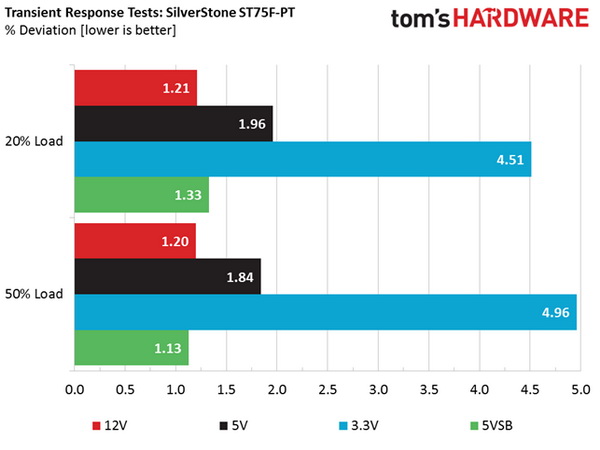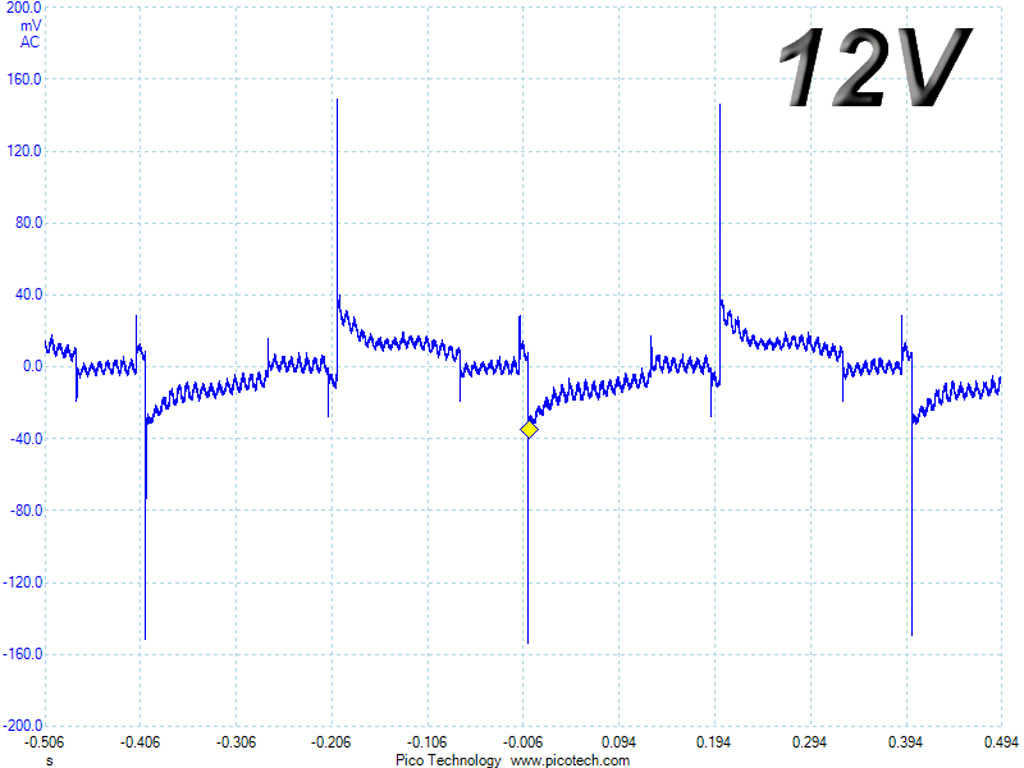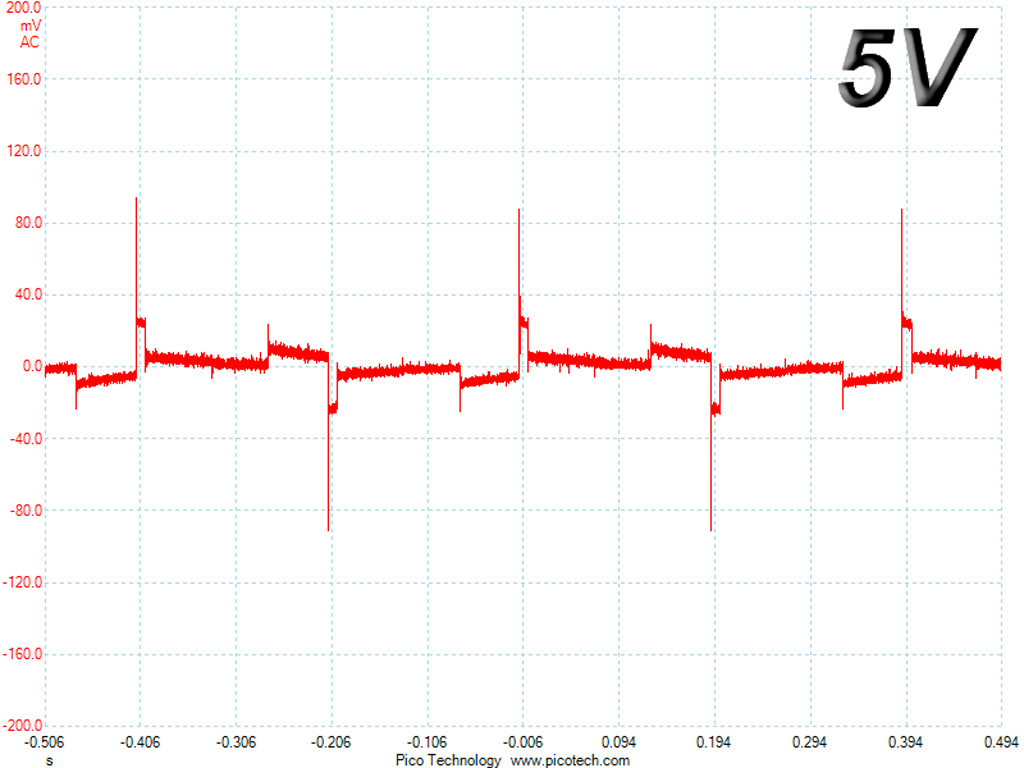SilverStone Strider Platinum 750W Power Supply Review
SilverStone recently expanded its Strider line with three new Platinum-rated units with capacities ranging from 550W to 750W. The family's flagship is being tested today, which includes fully modular cabling and compact dimensions.
Why you can trust Tom's Hardware
Transient Response Tests
Advanced Transient Response Tests
For details on our transient response testing, please click here.
In these tests, we monitor the response of the PSU in two different scenarios. First, a transient load (10A at +12V, 5A at 5V, 5A at 3.3V and 0.5A at 5VSB) is applied for 200ms while the PSU works at 20 percent load. In the second scenario, the PSU is hit by the same transient load while operating at 50 percent load. In both tests, we use our oscilloscope to measure the voltage drops caused by the transient load. The voltages should remain within the ATX specification's regulation limits.
These tests are crucial because they simulate the transient loads a PSU is likely to handle (such as booting a RAID array or an instant 100 percent load of CPU/GPUs). We call them "Advanced Transient Response Tests," and they are designed to be very tough to master, especially for PSUs with less than 500W capacity.
Advanced Transient Response at 20 Percent
| Voltage | Before | After | Change | Pass/Fail |
|---|---|---|---|---|
| 12V | 12.148V | 12.001V | 1.21% | Pass |
| 5V | 5.051V | 4.952V | 1.96% | Pass |
| 3.3V | 3.347V | 3.196V | 4.51% | Pass |
| 5VSB | 5.026V | 4.959V | 1.33% | Pass |
Advanced Transient Response at 50 Percent
| Voltage | Before | After | Change | Pass/Fail |
|---|---|---|---|---|
| 12V | 12.079V | 11.934V | 1.20% | Pass |
| 5V | 5.001V | 4.909V | 1.84% | Pass |
| 3.3V | 3.308V | 3.145V | 4.93% | Pass |
| 5VSB | 4.969V | 4.913V | 1.13% | Pass |





The deviations on the +12V rail are higher than we would like to see; the same applies to the 3.3V rail, which dropped below 3.2V in both tests. Only the 5V and 5VSB rails managed to register good enough performance.
Here are the oscilloscope screenshots we took during Advanced Transient Response Testing:
Transient Response At 20 Percent Load




Transient Response At 50 Percent Load




Turn-On Transient Tests
In the next set of tests, we measure the PSU's response in simpler transient load scenarios—during its power-on phase.
For the first measurement, we turn off the PSU, dial in the maximum current the 5VSB can output and switch on the PSU. In the second test, we dial the maximum load the +12V can handle and start the PSU while it's in standby mode. In the last test, while the PSU is completely switched off (we cut off the power or switch off the PSU by flipping its on/off switch), we dial the maximum load the +12V rail can handle before switching on the PSU from the loader and restoring power. The ATX specification states that recorded spikes on all rails should not exceed 10 percent of their nominal values (+10 percent for 12V is 13.2V, and 5.5V for 5V).
Get Tom's Hardware's best news and in-depth reviews, straight to your inbox.



The 5VSB slope isn't exactly smooth; however, there are no spikes or voltage overshoots. Things look better in the second test, although the rail needs some time until it reaches the nominal voltage. Finally, in the third test, we notice two small periods with excess ripple. Most likely the primary switching FETs have a hard time catching up with the sudden transition to full load operation from power-off mode.
Current page: Transient Response Tests
Prev Page Cross-Load Tests And Infrared Images Next Page Ripple Measurements
Aris Mpitziopoulos is a contributing editor at Tom's Hardware, covering PSUs.
-
babernet_1 Interesting, but I can't wait for a review on the 800W Titanium Silverstone!Reply
Again, you gave no price for your cost analysis. -
Aris_Mp the price is listed below every page. You have to disable add blocker in order to see it.Reply
For the record it is 145 bucks.
Now that I finished the Platinum review I will deal with the Titanium also. I am sorry for the delay but besides a very heavy schedule I need lots of time to fully evaluate each PSU. -
babernet_1 Ah, thank you. I disabled adblock for Toms and see it now. I am really seriously considering the titanium 800W supply. Hope it is good!Reply
-
Jack_565 I'm also considering buying the 800W Titanium version, it'd be awesome if you could do a review on one.Reply -
Aris_Mp will ask from SilverStone to provide me one, however my schedule is really heavy lately and the sample pile is growing huger day by day :(Reply